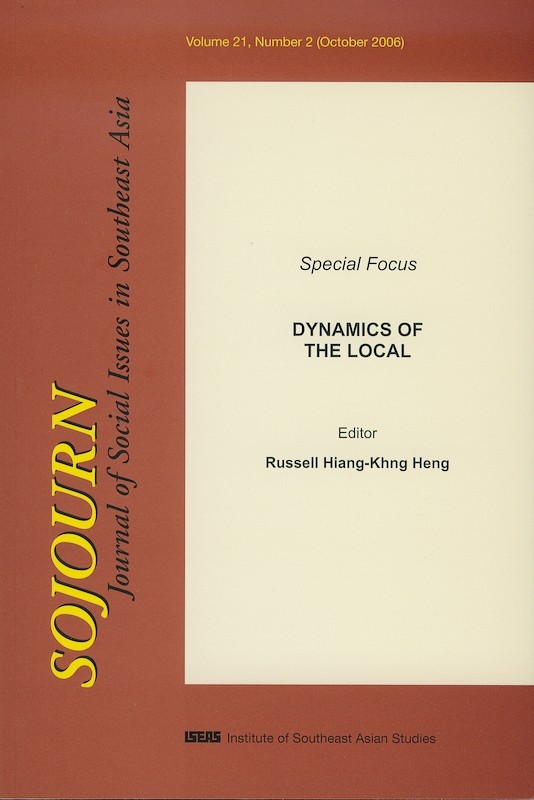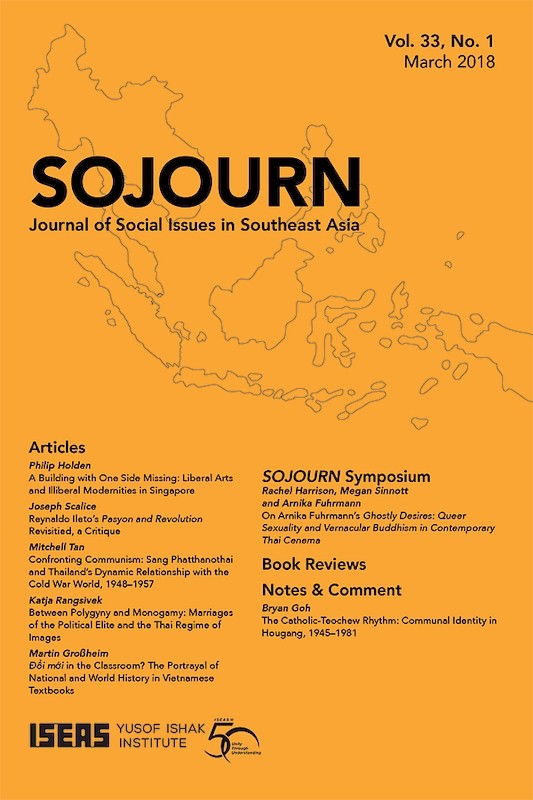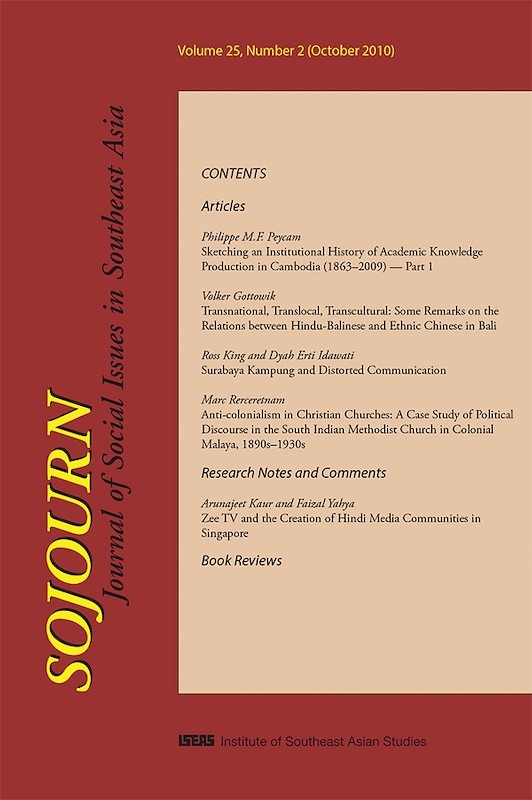SOJOURN: Journal of Social Issues in Southeast Asia Vol. 21/2 (October 2006). Special Focus on "Dynamics of the Local"

Russell Hiang-Khng Heng, editor
Date of publication:
January 2007
Publisher:
Institute of Southeast Asian Studies
Number of pages:
150
Code:
SJ21/2
Contents
-
SOJOURN: Journal of Social Issues in Southeast Asia Vol. 21/2 (October 2006). Special Focus on "Dynamics of the Local"
[Whole Publication] -
Preliminary Pages
- ARTICLES
-
Introduction: To Look at the Local Close-up, by Priyambudi Sulistiyanto, author
-
Little Bear Sells CDs and Ai Theng Drinks Coke: Sacred Clowning and the Politics of Regionalism in South Thailand, by Irving Chan Johnson, author see abstractImages of stock clowns from the traditional Thai shadow play (nang talung) are found throughout the villages and towns of the Thai Buddhist majority provinces of southern Thailand. These extremely popular funny men appear not only in shadow play performances but also in commercials, story books, logos, and billboards. Clowns also appear as tourist souvenirs, sacred amulets, crafted into statues, and the like as indigenous reflections of southern Thai identity. In this article, I discuss the complex and often ambiguous relationship between the clowns traditional sacred power and his forays into southern Thailands political and economic landscape. By so doing, I focus my attention on the clown as being both a subversive and conservative agent. On the one hand, he represents a Turnerian-like anti-structure, which allows him to test the limits of social and political acceptability and on which his ritual personality as a sacred being rests. On the other hand however, shadow play clowns are celebrated by puppeteers, local audiences and state officials as being embodiments of modernity and Thailands national quest for regional distinctiveness.
-
Grounded Cosmopolitans and the Bureaucratic Field: Musical Performance at Two Yogyakarta State Institutions, by Max M Richter, author see abstractDrawing on ethnographic research in Yogyakarta (Indonesia) in 2001, this article discusses two musical events with clear political dimensions. It seeks to broaden the parameters of discussion on music and politics by engaging two theoretical perspectives. The first, Bourdieus bureaucratic field, highlights various species of capital; the second, grounded cosmopolitanism, considers attitudes, practices, and outcomes not easily explained within a framework of political contestation. The cases explored are a campursari Awards Night at the Regional Parliament and a street music (musik jalanan) contest at the National Air Force Academy. While maintaining that musical performance cannot be reduced entirely to politics, the article concludes that the bureaucratic capital of physical force dominated the particular cases.
-
Between Empowerment and Power: The Rise of the Self-supporting Church in Western Flores, Eastern Indonesia, by Maribeth Erb, author see abstractThis article explores how ideas about empowerment often end up being manipulated by those in power, its implications, and what effect this has had on the trajectory of the Catholic Church in the western part of Flores during this period of revival, empowerment, and indigenization. What many have referred to as a decentralization of money politics into the provincial regions during the regional autonomy era seems to have reinforced an increasing emphasis on money in power configurations; this has occurred not only in local political dealings, but also in the church hierarchy. Against the wider historical background of the Catholic Church in Western Flores, particularly the rise of the self-supporting Church in the Manggaraian Diocese, this article examines developments of indigenizing and empowering the local Catholic community. The suggestion is that the conflicts in the Manggaraian Church reflect strains that have existed historically in the structure of the Catholic Church and represent tension within the Church between struggles for power over the community and efforts to empower the community.
-
Understanding the Cham Identity in Mainland Southeast Asia: Contending Views, by Mohamed Effendy Bin Abdul Hamid, author see abstractThe Cham people had established extensive and intense webs of relationships that encompassed activities in the economic, religious, cultural, and political spheres throughout maritime Southeast Asia. This article seeks to answer the question: What qualities do the Chams possess that allowed them to successfully participate in the cultural and social dynamics in societies other than their own? Throughout the course of this article, I attempt to locate Cham ethnicity in the context of several theories of Ethnicity. This will be followed by an attempt to address this issue through various means namely understanding the phenomenon of Cham Ethnic mobility throughout the perspective of layers i.e., the historical layer, the religious layer, and the oppressed minority. I argue that by analysing the Chams through the perspective of these layers, one is able to garner a more nuanced view of the Chams especially in regard to their ability to negotiate cultural and national boundaries of nation states in Southeast Asia.
- RESEARCH NOTES AND COMMENTS
-
Muhammadiyah, Local Politics and Local Identity in Kotagede, by Priyambudi Sulistiyanto, author
- BOOK REVIEWS
-
BOOK REVIEW: Singapore Civil Society and British Power. By E. Kay Gillis, by Ho Khai Leong, author
-
BOOK REVIEW: A State of Ambivalence: The Feminist Movement in Singapore. By Lenore Lyons, by Mandakini Arora, author
-
BOOK REVIEW: History, Buddhism, and New Religious Movements in Cambodia. Edited by John Marston and Elizabeth Guthrie, by Judy Ledgerwood, author
-
BOOK REVIEW: Constituting Unity and Difference: Vernacular Architecture in a Minangkabau Village. By Marcel Vellinga, by Roxana Waterson, author






